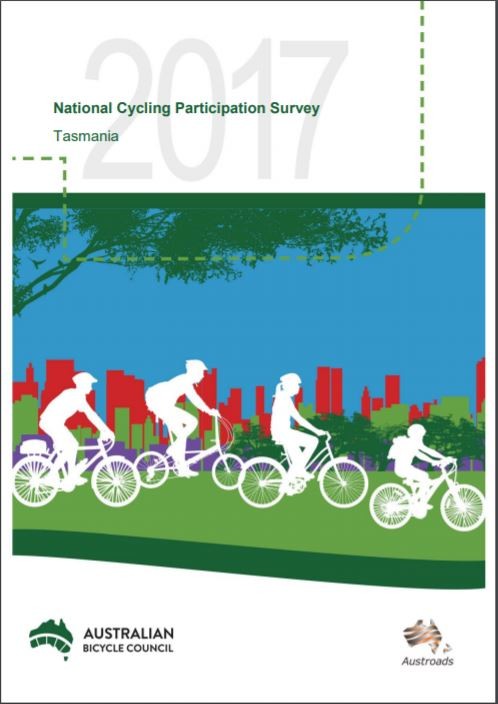2017 National Cycling Participation Survey (Tasmania)
The 2017 National Cycle Participation Survey has been released, with the Tasmanian report finding that 16% (95% CI: 13.8% - 18.3%) of Tasmanian residents ride a bicycle in a typical week. More than one third (34.9%, 95% CI: 32.3% - 37.4%) had done so in the past year.

I've always argued that this is however a bit of a misleading (positively biased) indicator for two main reasons:
- Survey Methodology: The Survey methodology is to ring up households in March/April and then ask the person that answers the phone (which you can usually assume is an adult) if they have used a car, bus, bike, train, tram etc. in the last seven days, if they answer no to the bicycle option, they are then asked if they have ridden a bicycle in the last week, two weeks, month, year etc. At the end of the survey, they are then asked a similar question for the other members of the household to derive a full snapshot of bicycle use in the survey.
Now while I congratulate the authors of the report for being so transparent in their methodology, I challenge the robustness of this approach on several grounds:
respondent bias, while I think the survey is really well designed for the initial respondent to indicate bicycle usage (by grouping it in with other modes of transport, making it clear that bicycle usage includes "even just riding in the backyard", and only then asking if they have ridden a bicycle in other periods after asking this question), I am less convinced that a parent then answering the question about their kids (or a partner about their husband/wife), who would then know this questionnaire is about cycling would provide a 100% unbiased answer.
There would, I suspect, be a temptation to think "No my kid/husband/wife didn't ride this week, but he/she has a bike and is a regular - so I'll say yes". Now I'm not saying everyone will do this, but I do think that some people would do this, and hence this would lead to a overstatement of cycling activity
Sampling period bias - the survey is done in March/April (a peak cycling period) and asks people to then project backwards in time (over summer) when thinking about their cycling activity, and so it can be expected that the responses about cycling in the last week or month reflect a high cycling activity period, not the average. - Reporting Format: The survey reports this "did you cycling in the last week / month" question into a statement that "X% of residents ride a bicycle in a typical week or month" which I find is the figure that is often reported, and which can be misleading as it downplays the huge gap between child (
But with these concerns aside, if you read the full report you can get some excellent insights into cycle participation in the State, including:
- Cycling participation in Tasmania, measured by those who had ridden in the last week, was 16% for Tasmanian, broken down into 47% (0-9 year olds), 36% (10-17 year olds), 13% (18-29 year olds), 10% (30-49 year olds) and 4% (50+ year olds). This was not statistically different from previous years.
- Among those who had ridden in the past year and were aged 15 or over who had indicated they had been riding continuously for more than a year, more (40%) indicated they were riding less often than more often (18%) compared to a year ago (Figure 2.7). The proportion indicating they were riding less often has increased since 2013 when this question was first asked.
- Of the people who cycled in the last month, 86% cycled for recreation and 17% used a bicycle for transport.
- Just over half of households in Tasmania have access to at least one working bicycle. The proportion of households with access to a bicycle in regional Tasmania may be slightly higher than in Hobart.
- Respondents who had ridden in the past year were asked whether they had traveled to work, education (school or university), shopping, public transport or participated in recreational exercise or fitness in the past year. For those that had undertaken these activities, they were asked whether they had ridden a bicycle for any of these purposes. Most of those who had ridden in the past year had done so at least once for recreation or exercise (96%), and half (51%) had done so for shopping. Only 9% had commuted by bike and 27% had cycled to reach and education school.
- Respondents were asked to prioritise actions that would encourage bicycle riding. The most supported actions were:
- Better connections between bike paths and schools (75% of respondents rated this a very high or high priority),
- more off-road paths and cycleways (70%),
- more on-road bicycle lanes (69%),
- more signs highlighting bicycle routes (59%), and
- better connections between bike paths and shops (51%).
The reports for Australia and each of the States are available on the Australian Bicycle Council website, and the Tasmanian report is in the attachments section below.
When you subscribe to the blog, we will send you an e-mail when there are new updates on the site so you wouldn't miss them.